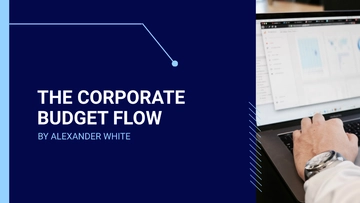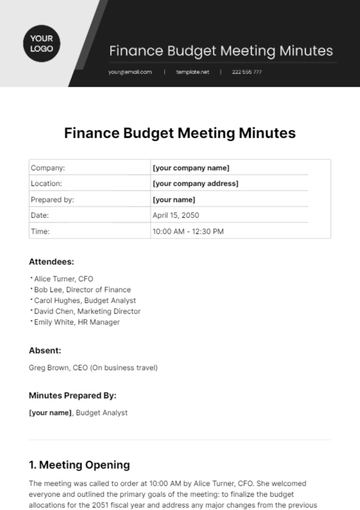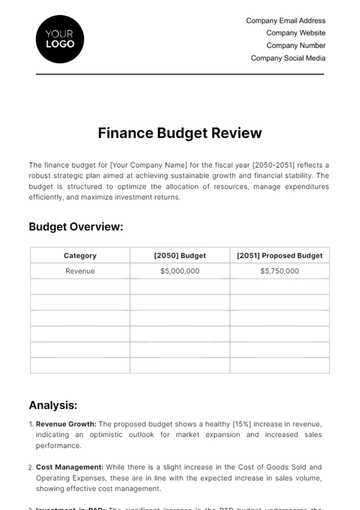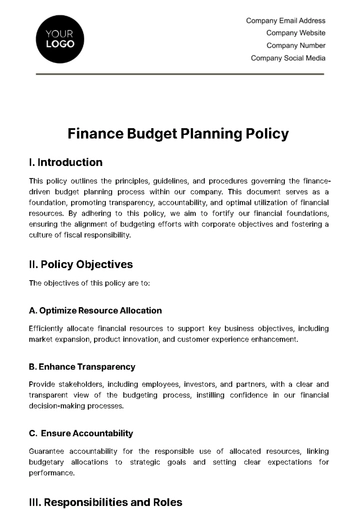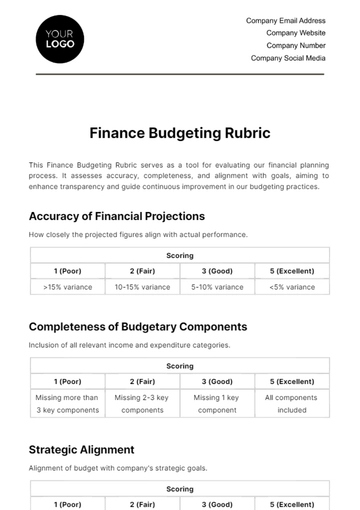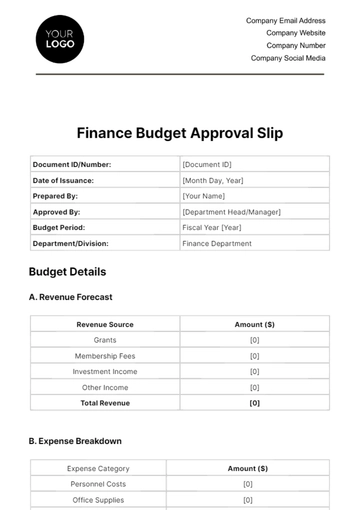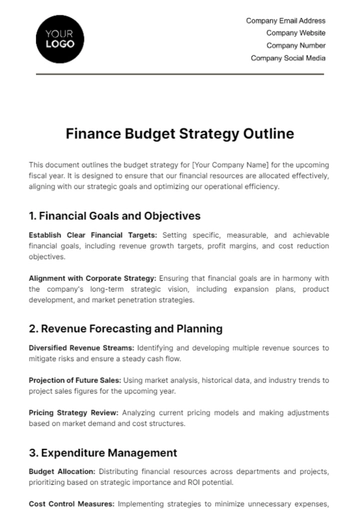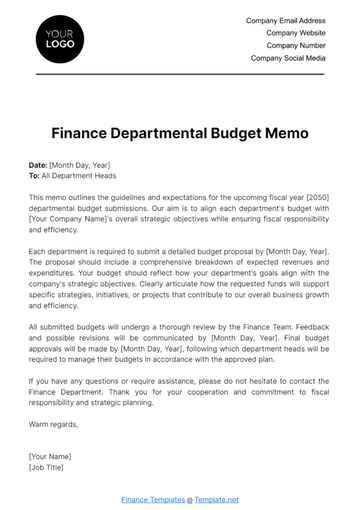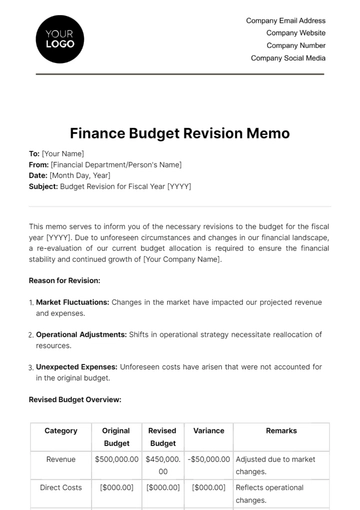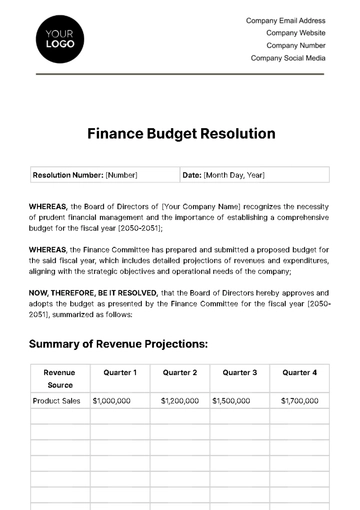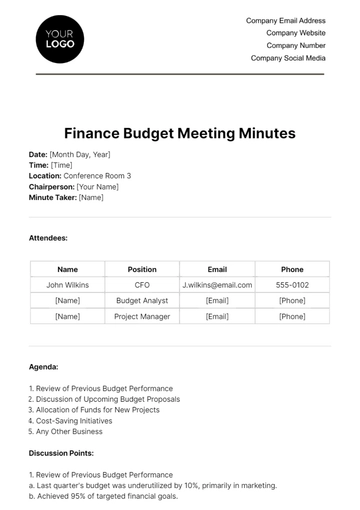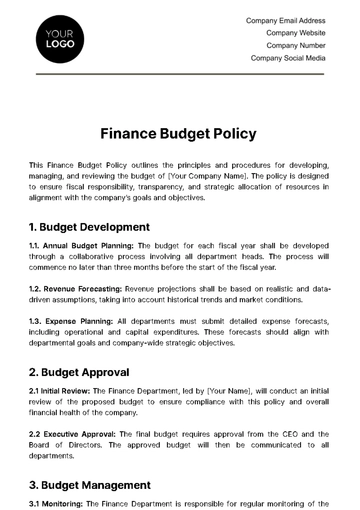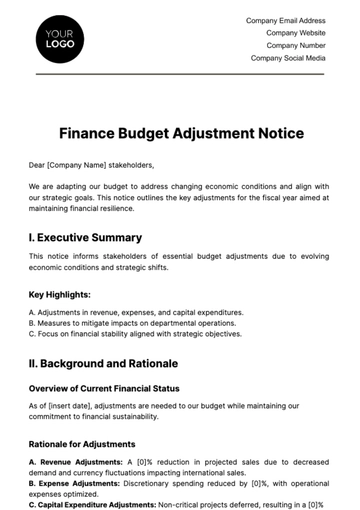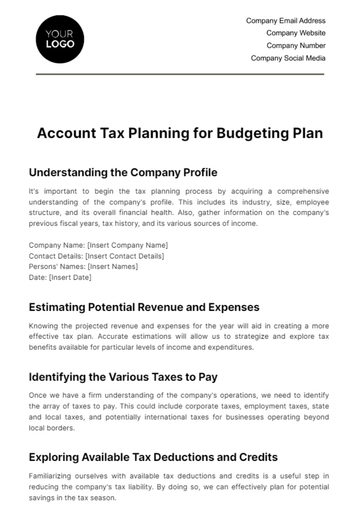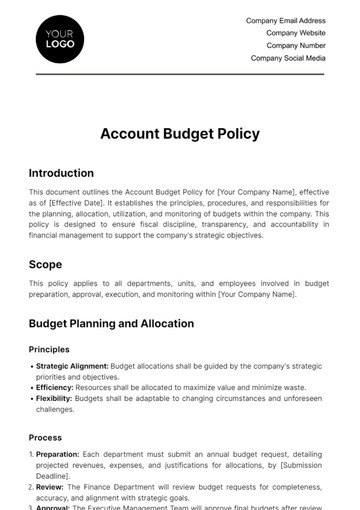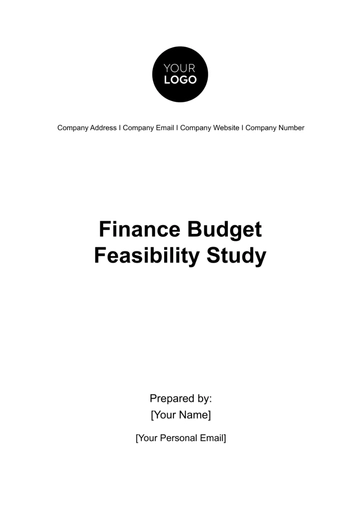Free Multi-Year Finance Budget Document
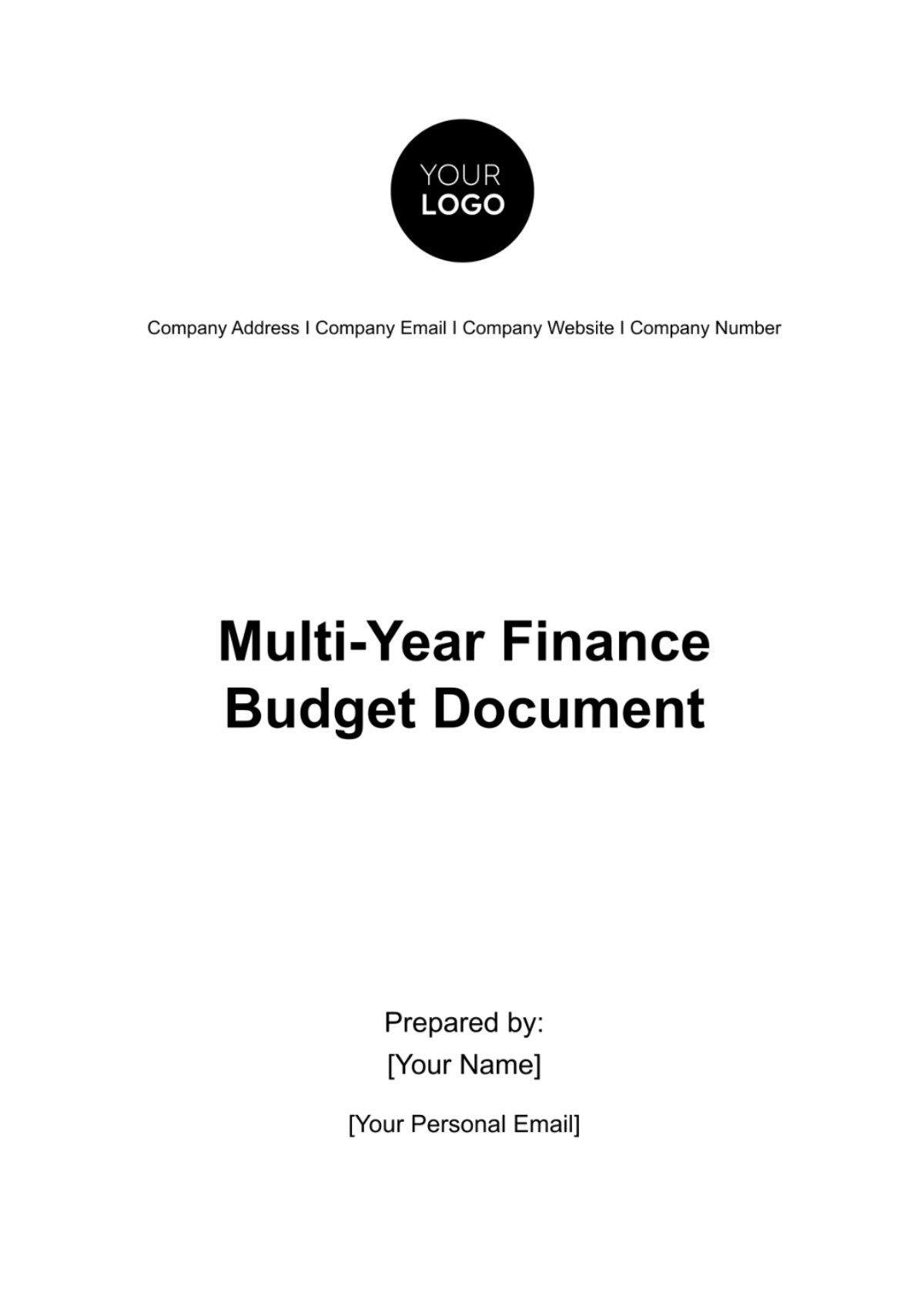
Executive Summary
This Multi-Year Finance Budget Document serves as a strategic roadmap for [Your Company Name], detailing our financial trajectory over the next three fiscal years, commencing on [Month Day, Year]. This document has been meticulously crafted to provide a clear and comprehensive overview of our financial goals, strategies, and operational directives. It is designed to support informed decision-making and ensure the company's financial stability and growth.
Our approach encompasses a robust analysis of projected revenues and expenditures, reflecting both our current market position and anticipated changes in the business environment. We have identified key revenue streams that will drive our growth. This analysis is complemented by a thorough examination of our anticipated expenses, categorized major expenditures, allowing us to maintain a balanced budget and ensure efficient resource allocation.
A significant component of this document is our capital budgeting plan. This section outlines our strategies for major investments and capital expenditures, ensuring that they align with our long-term objectives and expected return on investment. We have evaluated potential projects and investments through rigorous financial modeling, considering factors like cost, potential returns, and payback periods.
Budget Overview
The budget overview section of [Your Company Name]'s Multi-Year Finance Budget Document provides an in-depth analysis of our projected financial performance for the next three fiscal years. This segment is crucial in understanding the company's anticipated financial health and sets the stage for strategic decision-making. It includes detailed forecasts for both revenue and expenditure, offering a comprehensive view of the company's fiscal trajectory.
2.1 Revenue Forecast
The revenue forecast is an integral part of our financial planning. It reflects our expectations for income over the next three fiscal years, considering various revenue streams that contribute to the company's overall financial growth. These projections are based on current market trends, historical data, and strategic business plans.
Fiscal Year | Revenue Streams | Projected Revenue ($) |
|---|---|---|
Year 1 | Product Sales | $120,000 |
2.2 Expenditure Forecast
The expenditure forecast details our anticipated expenses for the coming three fiscal years. This forecast is categorized into various operational and capital expenditures, allowing us to allocate resources efficiently and maintain a balanced budget. The expenditure categories include, but are not limited to, operational costs, marketing, R&D, and capital investments.
Fiscal Year | Expenditure Categories | Projected Expenditure ($) |
|---|---|---|
Year 1 | Operational Costs | $80,000 |
Budget Breakdown
The budget breakdown is a detailed analysis of [Your Company Name]'s financial performance, segmented into individual fiscal years. This section provides a quarter-by-quarter breakdown of revenues, expenditures, and net income for each year, offering a granular view of the company's financial operations. This breakdown allows for close monitoring and adjustment of financial strategies as needed, ensuring that the company remains on track to meet its financial goals.
Category | Q1 | Q2 | Q3 | Q4 | Total |
|---|---|---|---|---|---|
Revenues | $30,000 | $35,000 | $40,000 | $45,000 | $150,000 |
Capital Budgeting
The Capital Budgeting section of [Your Company Name]'s Multi-Year Finance Budget Document is a critical component that outlines our approach to long-term investments. This chapter delves into the strategic allocation of financial resources towards significant projects that are essential for the company's growth and sustainability. Capital budgeting is a vital process as it involves making decisions about investments that will shape the company's future, requiring careful analysis of costs, benefits, potential returns, and associated risks.
Below is a table summarizing the details of the identified capital projects:
Capital Project | Cost Estimate | Expected ROI | Payback Period |
|---|---|---|---|
Expansion of Facilities | $500,000 | 15% | 5 Years |
This Capital Budgeting overview is designed to provide stakeholders with a clear understanding of where and how the company's capital resources will be invested. It reflects our commitment to making strategic, data-driven decisions to foster growth, innovation, and enhanced operational efficiency.
Assumptions and Methodologies
In the development of [Your Company Name]'s Multi-Year Finance Budget Document, we have employed a set of financial assumptions, models, and methodologies that are fundamental to the budgeting process. This chapter elucidates these elements, providing transparency and context to our financial planning and forecasting efforts.
Assumptions:
The financial projections in our budget are based on a series of assumptions that reflect our understanding of the current and future business environment. These include:
Market Growth Rates: We assume an annual market growth rate of [0]%, considering industry trends, economic forecasts, and competitive dynamics.
Inflation Rates: An average inflation rate of [0]% per year is factored into our cost projections.
Sales Volume and Pricing: Sales projections are based on historical data trends and market research, assuming a [0]% increase in sales volume year-over-year.
Cost Increases: For expenditures, we anticipate a yearly increase of [0]% in line with historical trends and inflationary pressures.
Capital Expenditure Requirements: We assume that our identified capital projects will be carried out as planned, with costs and returns as projected.
Models:
To ensure accuracy and reliability in our financial forecasts, we use several financial models:
Revenue Forecasting Models: Utilizing time-series analysis and market trend data to predict future revenues.
Expenditure Modeling: Applying cost-accounting principles to estimate future expenses based on planned activities and historical data.
Cash Flow Projections: Using direct and indirect methods to forecast cash flows, ensuring liquidity and operational efficiency.
Capital Budgeting Models: Employing techniques like Net Present Value (NPV), Internal Rate of Return (IRR), and Payback Period analysis for capital project evaluations.
Methodologies:
Our budgeting process incorporates a blend of methodologies to ensure comprehensiveness:
Top-Down and Bottom-Up Budgeting: Combining broad strategic targets with detailed departmental budgets for accuracy and alignment.
Zero-Based Budgeting: For certain expenditure categories, starting from a zero base each year to ensure cost-effectiveness and efficiency.
Scenario Planning: Developing multiple financial scenarios to anticipate and prepare for various business conditions.
Continuous Monitoring and Adjustment: Regularly reviewing financial performance against the budget and making adjustments as necessary.
Risk Analysis and Mitigation Strategies
In this chapter, we address the potential risks associated with [Your Company Name]'s revenue streams, expenditures, and capital investments. Identifying and analyzing these risks is crucial for implementing effective strategies to mitigate their impact. Our approach involves a thorough examination of various risk factors and the development of tailored strategies to manage them effectively.
Risks Associated with Revenue Streams
a. Market Fluctuations: The demand for our products or services may be impacted by market volatility.
Mitigation Strategy: Diversify product offerings and expand into new markets to reduce dependence on a single market segment.
b. Competition: Increased competition could lead to a loss of market share.
Mitigation Strategy: Continuously innovate and improve product quality. Implement aggressive marketing strategies to enhance brand visibility and loyalty.
c. Customer Dependency: Relying heavily on a few major customers can be risky.
Mitigation Strategy: Broaden the customer base and establish long-term contracts with key clients to ensure stable revenue streams.
Risks Associated with Expenditures
a. Cost Overruns: Unexpected increases in operational costs can impact profitability.
Mitigation Strategy: Implement strict budget controls and regularly monitor expenses. Develop contingency plans for unforeseen cost increases.
b. Supply Chain Disruptions: Disruptions can lead to increased costs or delays.
Mitigation Strategy: Develop a diversified supplier network and maintain strategic inventory levels to cushion against supply chain volatility.
Risks Associated with Capital Investments
a. Project Delays or Failures: Capital projects may not be completed on time or deliver expected results.
Mitigation Strategy: Conduct thorough due diligence before project initiation and maintain rigorous project management practices.
b. Technology Obsolescence: Rapid technological changes can render a project obsolete.
Mitigation Strategy: Invest in adaptable and upgradable technology solutions. Stay abreast of technological advancements in the industry.
Conclusion
As we conclude this Multi-Year Finance Budget Document, the financial outlook for [Your Company Name] over the next three years appears robust and promising. Our comprehensive planning has laid a solid foundation for sustainable growth, financial stability, and resilience against market fluctuations. The detailed revenue and expenditure forecasts, coupled with strategic capital budgeting, reflect our commitment to prudent financial management and strategic investment.
- 100% Customizable, free editor
- Access 1 Million+ Templates, photo’s & graphics
- Download or share as a template
- Click and replace photos, graphics, text, backgrounds
- Resize, crop, AI write & more
- Access advanced editor
Template.net's Multi-Year Finance Budget Document Template offers a comprehensive, editable solution for businesses planning their financial future. With detailed sections on revenue forecasts, expenditures, and capital budgeting, it's designed for strategic clarity and fiscal precision. Streamline your multi-year financial planning with this user-friendly, professionally crafted template, adaptable to your specific business needs with help from our AI editor tool for full customization.
You may also like
- Budget Sheet
- Personal Budget
- Non Profit Budget
- Monthly Budget
- Project Budget
- HR Budget
- Company Budget
- Home Budget
- Weekly Budget
- College Budget
- Business Budget
- Construction Budget
- Small Business Budget
- Hotel Budget
- Annual Budget
- Home Renovation Budget
- Household Budget
- Student Budget
- Grocery Budget
- Marketing Budget
- Corporate Budget
- Startup Budget
- Manufacturing Budget
- Church Budget
- University Budget
- Annual Budget Plan
- Event Budget
- Operating Budget
- Travel Budget
- Food Budget
- IT and Software Budget
- School Budget
- Real Estate Budget
- Sales Budget
- Conference Budget
- Budget Finance
- Freelancer Budget
- Budget Advertising
